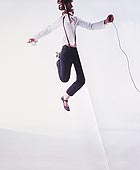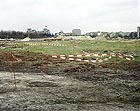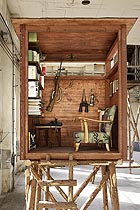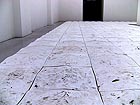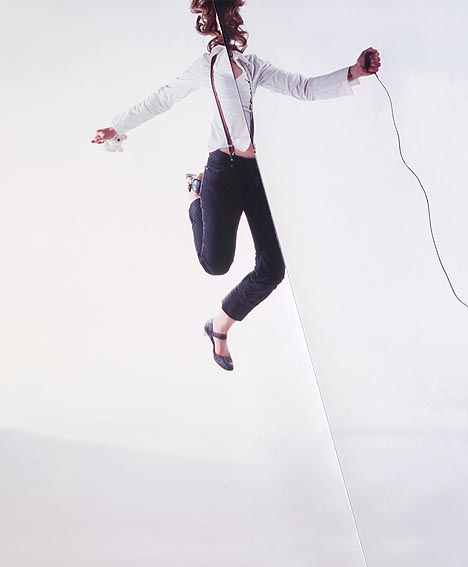
translated and summarized by: Liz Wollner-Grandville,
English summary December 17 - January 10
MMKK Museum Moderner Kunst Kärnten: Contemporary photography. New positions from Austria
The next performance
The photographs shown in the first room trigger a moral punch in the solar plexus: people in suits traversing a body of water, boat people floating on the sea, and detention rooms spread a feeling of oppression. The exhibit “Contemporary photography. New positions from Austria”, curated by Sylvie Aigner, commences with works by Borjana Ventzislavova, Lukas M. Hüller and Gisela Erlacher – and with the number one topic throughout Europe, thanks to right-wing parties such as the Alliance for the Future of Austria (BZÖ).
Could it be that the venue of the exhibition – the capital of Carinthia – is the reason for the immediate confrontation with the topic, although the exhibition covers a much broader spectrum. Works by young artists who only recently graduated from art school are presented side by side with those by established colleagues. The common denominator of Nina Rike Springer’s ingeniously staged photographs and Anja Manfredi’s works is their interest in the theatrical. And Manfredi carries this to the extreme with her amusing as well as intense video, in which the artist repeatedly asks “Wo ish die näxte Perrrformance?” (Where is the next performance?) with a broad Tyrolean accent. Other works deal with nature (Jutta Strohmaier, Markus Guschelbauer, Robert F. Hammerstiel), urbanism and traffic (Hubert Blanz, Clemens Fürtler, Michael Inmann) or the value of painting in times of film and video (Gernot Fischer-Kondratovitch). The exhibition concludes with Therese Cassini ‘s installation in which she invites people to enjoy “light meals” (transparent food).
While the search for a central theme remains futile, the exhibition manages to score by presenting artistic confrontations and lesser-known artists. Nevertheless, the selection of the participants could be described as rather inscrutable.
By Nina Schedlmayer
MMKK Museum Moderner Kunst Kärnten
9020 Klagenfurt, Burggasse 8/Domgasse, until 31.01.10
www.mmkk.at
Berlinische Galerie: BERLIN 89/09 – Art between traces of the past and utopian futures
20 years after the fall of the Berlin Wall - the next anniversary: 20 years of unification. The era that commenced immediately following the unification is still difficult to separate from the present day. It therefore makes sense that the exhibition focusss on this gap. But the exhibition is not very convincing: the central theme seemed to be Berlin; at least that was the credo. And the Berlinische Gallery failed to see itself as an interesting starting point, especially considering its own instable history: from its founding as an association in 1975 to its current premises in Berlin Kreuzberg.
“The capital Berlin, rumpled by excavators, is drowning in optimism” the head of the Neue Berliner Kunstverein, Marius Babias described the atmosphere in the years immediately after the fall of the Wall, and points to the significant ambivalence: the euphoria following the unification, the awareness that one was experiencing a substantial caesura, and simultaneously the disillusionment in view of exaggerated expectations and ambitions. Even detached from the unbelievable “Eastalgia”-wave, a quiet melancholy spreads with reference to what remains of the GDR. And because it has always been difficult to visualize ideologies or collective sentiment, architecture offered a remedy: Tacita Dean (“Palast” 2005) devotes herself to the demolished Palace of the Republic by catching distorted reflections in windows panes and thereby translates the deceptive part of this quickly glorified motif into a nostalgia-drained picture language. Nina Fischer & Maroan el Sani are interested in the prestigious GDR building as well as the club scene of the new Berlin, and create small monuments. By reconstructing the buildings of the so-called Eastern Modernism, Karsten Konrad’s works “Lost Island” (2004) and “GDR (outside)” (2005) attempt to save them from obsolescence.
How strongly Berlin’s landscape was characterized by building sites becomes apparent with the numerous contributions, including Lois Weinberger’s gardening interventions in urban space, Arwed Messmer’s bleak impressions of the famous Potsdam Square as a despairing steppe or Reynold Reynold’s staccato-like sequencing of photos, which becomes even more intense through the impressive 2-canal video installation accompanied by rapidly recited text passages (“Stadtplan”, 2005). And Delbrügge & de Moll’s work “Artist Migration Berlin” (2006) offers the most apt commentary on the situation of the still ongoing art-hype: low rents, the abundance of cultural events and the even today tangible transition of the city, are still good reasons to move to Berlin. But in the video interviews with artists from other countries, who talk about their experiences in Berlin, this glorified image begins to falter – “poor, but sexy” simply remains to be an unfortunate phrase.
By Naoko Kaltschmidt
Berlinische Galerie
10969 Berlin, Alte Jakobstrasse 124 – 128, until 15.02.10
www.berlinischegalerie.de
Kunsthalle Krems: Mark Dion – Concerning Hunting
Proud prey
Golf was once the favoured pastime – now it’s hunting – at least in Austria: the country’s elite prefers to meet on the deer stand. Mark Dion’s show “Concerning Hunting” excellently matches the Kunsthalle Krems, as the town of Krems is considered the secret capital of the Province of Lower Austria, ruled by the powerful Raiffeisenbank and Erwin Pröll. But these regional affairs are of no concern to the American artist.
Dion’s solo presentation – already partly displayed at the Gallery Georg Kargl and the Kunstraum Dornbirn – deals with the cultural exaggeration of hunting and nature. In his work “Tar Museum” Dion shows tar-covered animals standing on boxes and creates associations to photos published in the aftermath of oil tanker accidents as well as presentation-techniques of museums. The artist then devotes himself to the utensils and clichés related to hunting and hunters: he presents dummies draped in an elegant red jacket and holding a hunting horn or in a camouflage jacket and rubber boots, each representing certain stereotypes. He also shows standards decorated with comic-like boar heads, deer or bears, and an assemblage of targets decorated with animal images. Individually equipped deer stands are meant to identify certain types of hunters: the “gourmand” who lays the table with meticulously chosen dishes or the “librarian”, with a stand full of literature.
Even if all of this is rather amusing, the most revealing part of the exhibition is the hunting photos, mounted randomly on a wall: the pride with which children, men and women present their prey, and with which cadavers are arranged next to one another, speaks volumes.
By Nina Schedlmayer
Kunsthalle Krems
3504 Krems, Steiner Landstrasse 8, until 28.02.10
www.kunsthalle.krems.at
Startgalerie im Museum auf Abruf: Fabian Fink – Yesterday’s Parties
The ground beneath one’s feet
Fabian Fink, born 1979 in Salzburg, dared to undertake an exciting and courageous experiment: a huge installation, which is spread across the entire gallery floor. After one ventures to set foot on the installation, comprised of 304 convex-shaped plasterboards, the creation is highly impressive.
An awkward feeling arises while walking around on the rather fragile and wavy surface. The ground beneath one’s feet begins to wobble letting associations such as “losing ground under one’s feet” or “entering shaky terrain” emerge.
Conceptual art is presented and made tangible that is not dependent on intellectual and contextualizing comprehension The actual strength of this installation lies in the perception of an experience outside the realm of everyday life, as well as a modified awareness of one’s self and the world.
Already the title of the exhibition, with its insinuation to Andy Warhol’s favourite song “All Tomorrow’s Parties” sung by The Velvet Underground and Nico, reveals in which tradition this art can be classified. Happenings as well as concept art, which mark the 1960’s and 1970’s in the USA, form the background for this courageous and noteworthy work. Fink’s approach reminds of Allan Kaprow’s installation “Yard” (1961), in which hundreds of used car tyres were piled in the narrow garden behind the Martha Jackson Gallery in New York, thereby creating one of his extraordinary Environments.
By Wolfgang Pichler
Startgalerie im Museum auf Abruf
1010 Vienna, Felderstrasse 6-8, next to the city hall, until 14.01.10
www.musa.at
Mehr Texte von translated and summarized by: Liz Wollner-Grandville


 Teilen
Teilen

